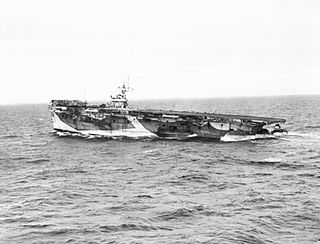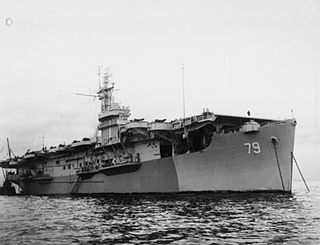The escort carrier or escort aircraft carrier, also called a "jeep carrier" or "baby flattop" in the United States Navy (USN) or "Woolworth Carrier" by the Royal Navy, was a small and slow type of aircraft carrier used by the Royal Navy, the United States Navy, the Imperial Japanese Navy and Imperial Japanese Army Air Force in World War II. They were typically half the length and a third the displacement of larger fleet carriers, slower, carried fewer planes, and more-lightly armed and armored. Escort carriers were most often built upon a commercial ship hull, so they were cheaper and could be built quickly. This was their principal advantage as they could be completed in greater numbers as a stop-gap when fleet carriers were scarce. However, the lack of protection made escort carriers particularly vulnerable, and several were sunk with great loss of life. The light carrier was a similar concept to the escort carrier in most respects, but was fast enough to operate alongside fleet carriers.

HMS Fencer (D64/R308) was an American-built Attacker-class escort carrier that served with the Royal Navy during the Second World War.

USS St. George (CVE-17) was laid down on 31 July 1941 as a C3-S-A2 by Ingalls Shipbuilding, Hull 296 of Pascagoula, Mississippi, under Maritime Commission contract as the (second) SS Mormacland for Moore-McCormack Lines, Inc.,. She was renamed St. George (AVG-17) by the United States Navy on 7 January 1942; and assigned to the United Kingdom under Lend-Lease as HMS Pursuer on 24 February 1942. The vessel was launched on 18 July 1942, sponsored by Mrs. Mary Ann S. Bartman. The escort carrier was reclassified ACV-17 on 20 August 1942, acquired by the US Navy and simultaneously transferred to Britain on 14 June 1943. She was reclassified CVE-17 on 15 July 1943.

USS Pybus (CVE-34) was initially a United States Navy Bogue-class escort carrier. The ship was transferred to the United Kingdom for service in the Royal Navy as the Ruler-class escort carrier HMS Emperor (D98) as part of the Lend-Lease program of World War II. Entering service in 1943, the ship took part in operations against the German battleship Tirpitz and the invasions of Normandy and southern France. Returned to the United States following the war, the carrier was sold for scrap in 1946.

HMS Nabob (D77) was a Ruler-class escort aircraft carrier which served in the Royal Navy during 1943 and 1944. The ship was built in the United States as the Bogue-classUSS Edisto (CVE-41) but did not serve with the United States Navy. In August 1944 the ship was torpedoed by the German submarine U-354 while participating in an attack on the German battleship Tirpitz. Nabob survived the attack, but upon returning to port, was considered too damaged to repair. The escort carrier remained in port for the rest of the war and was returned to the United States following it. Nabob is one of two Royal Navy escort carriers built in the United States which is listed as lost in action during World War II. The ship was sold for scrap by the United States but found a second life when purchased and converted for mercantile use under her British name, Nabob. Later renamed Glory, the ship was sold for scrapping in 1977.

USS St. Simon (CVE-51), an escort aircraft carrier originally classified as an auxiliary aircraft carrier, was laid down on 26 April 1943 at Tacoma, Washington, by the Seattle-Tacoma Shipbuilding Corporation, under a Maritime Commission contract ; reclassified as an escort aircraft carrier, CVE-51, on 15 July 1943; launched on 9 September 1943; sponsored by Mrs. R. H. Lewis, the wife of Major General R. H. Lewis, Commanding General, Northwestern Sector, Fort Lewis, Washington; assigned to the Commercial Iron Works, Portland, Oregon, for the completion of construction; and delivered to the Royal Navy, under lend-lease, on 31 December 1943.

USS Willapa (AVG-53/ACV-53/CVE-53) was a Bogue-class escort carrier built during World War II for the United States Navy. Never seeing American service, the ship was transferred to the United Kingdom as part of Lend-Lease. The escort carrier was renamed HMS Puncher (D79) of the British Ruler class and crewed by the Royal Canadian Navy with aircrew from the Fleet Air Arm. Primarily used as an aircraft transport, Puncher took part in operations along the Norwegian coast towards the end of the war. Following the war the ship was converted for mercantile service and renamed Muncaster Castle, Bardic and Ben Nevis, before being broken up in 1973.

HMS Tracker (BACV-6/D24) was a Attacker-class escort carrier that was built in the United States, but served in the Royal Navy during World War II.

HMS Biter was a Royal Navy escort carrier during the Second World War. She was laid down as a merchant ship at the Sun Shipbuilding & Drydock Company yard at Chester, Pennsylvania. Laid down on 28 December 1939, she was converted to an escort carrier and commissioned in the Royal Navy on 6 May 1942. She was returned to the United States in 1945 and subsequently lent to France.
HMS Audacity was a British escort carrier of the Second World War and the first of her kind to serve in the Royal Navy. She was originally the German merchant ship Hannover, which the British captured in the West Indies in March 1940 and renamed Sinbad, then Empire Audacity. She was converted and commissioned as HMS Empire Audacity, then as HMS Audacity. She was torpedoed and sunk by a German U-boat in late 1941.

HMS Archer was a Long Island-class escort carrier built by the United States in 1939–1940 and operated by the Royal Navy during World War II. She was built as the cargo ship Mormacland, but was converted to an escort carrier and renamed HMS Archer. Her transmission was a constant cause of problems which led to her being withdrawn from front-line service. She was used as a stores ship and then as an accommodation ship before a refit and subsequent use as a merchant aircraft ferry ship, Empire Lagan.

HMS Ravager (D70) was an Attacker-class escort carrier built in the United States and operated by the Royal Navy during World War II.

USS Cushing was a torpedo boat in the United States Navy during the Spanish–American War. She was named for William B. Cushing.

The Avenger-class escort carrier was a class of escort carriers comprising three ships in service with the Royal Navy during the Second World War and one ship of the class in the United States Navy called the Charger Type of 1942-class escort carrier. All three were originally American type C3 merchant ships in the process of being built at the Sun Shipbuilding and Drydock Company Chester, Pennsylvania. The ships laid down in 1939 and 1940 were launched and delivered to the Royal Navy by 1942 under the Lend-Lease agreement.

The Attacker class were a class of escort aircraft carriers in service with the British Royal Navy during the Second World War.

HMS Avenger was a Royal Navy escort aircraft carrier during the Second World War. In 1939 she was laid down as the merchant ship Rio-Hudson at the Sun Shipbuilding & Drydock Company yard in Chester, Pennsylvania. Launched on 27 November 1940, she was converted to an escort carrier and transferred under the lend lease agreement to the Royal Navy. She was commissioned on 2 March 1942.

HMS Blake, named in honour of Admiral Robert Blake, was the lead ship of her class of protected cruiser that served in the Royal Navy from 1889 to 1922.













